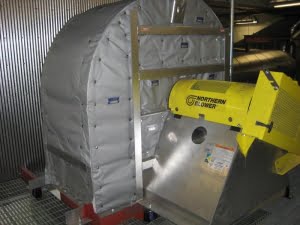In the early days of removable insulation covers, fabrication processes were quite variable and many blankets underperformed, which hurt their product reputation. Often times blankets were held together with wires and couldn’t withstand the outdoor elements. Removable insulation has come a long way since those days – and the materials, processes, and benefits have greatly improved.
Now, removable insulation covers have many advantages and this article will help clarify some of the misconceptions from their early days in the market. Here are the top 5:
Misconception 1:
Removable insulation doesn’t insulate as well as conventional or traditional insulation.
If manufactured correctly, removable insulation actually does an equal or better job insulating than traditional materials, like fiberglass. This is because it can fit the pipe better over time. Pipes expand and contract, and instead of gradually breaking down (the way traditional insulation does), removable insulation covers can be adjusted using Velcro straps. Removable insulation systems are actually made by sewing conventional insulation into textile jackets, which helps with the longevity of the insulation’s thermal performance.
Misconception 2:
Removable insulation covers cannot be used outside.
With coated textiles, like silicone and Teflon, removable jackets are used outdoors all the time. One of the largest outdoor applications is actually freezing protection, where removable insulation helps outdoor mechanical and steam systems stay up and running year-round.
There are also sewing techniques that help keep water out by design where stitching and seams are on the inside of the removable jacket. This way, these susceptible components of the removable insulation are not exposed to the elements.
Fit Tight Covers offers a wide range of insulation jackets that can help prevent freezing and can be used anywhere. With the custom nature of our business, FTC always asks questions about the operating environment to ensure your custom removable insulation will provide optimal performance.
Misconception 3:
Insulation blankets are only held together with wire.
In the early days of removable insulation, wire was the most common method to cinch down the blanket onto the pipe system. Over time, more efficient and effective securement methods were tested and ultimately proved out in the market. The best-in-class standard for your removable cover should be a “belt and suspenders” approach with multiple securement points. This is the standard that Fit Tight Covers follows in all their designs for removable insulation. This will include insulation blankets held together with: 2″ Nomex Velcro, 1″ Straps and Stainless Steel D-Rings, 3/16″ Braided Kevlar Drawstrings and 12ga Stainless Steel Lace Hooks and Quilt Pins.
Misconception 4:
Removable insulation is bad for the environment.
Traditional and conventional insulation materials cannot be recycled or reused once they’re torn off. The need to access your insulated mechanical systems and equipment can vary on maintenance requirements and plant operations, but actually, be quite frequent. This makes removable insulation blankets an excellent option because they can be used over and over again. Both removable insulation and traditional materials have a huge net positive on your carbon footprint through energy savings and enabling thermal efficiency.
Misconception 5:
Removable insulation will cause skin irritation.
Conventional insulation, specifically fiberglass, is known for irritating skin if the proper safety clothing and PPE are not being used. However, removable insulation covers have textiles encapsulating the insulation on both the inside and outside – meaning you don’t have the ability to even touch the fiberglass, which makes for an easy and worry-free installation.
Get Started Today
Fit Tight Covers’ unique fabrication process is based on 25 years of testing and development, resulting in the best-designed insulation covers utilizing the best materials. If you’re interested in learning more about custom thermal insulation covers, request a quote today!







